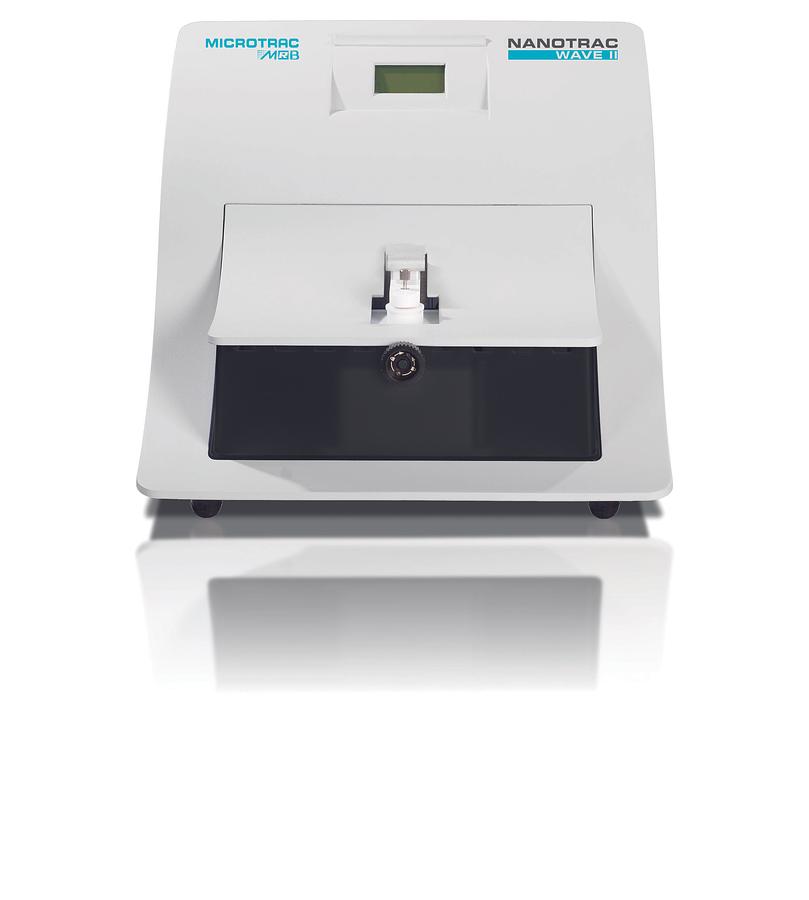Featuring an enhancement to traditional DLS, Microtrac MRB’s Nanotrac Wave II employs Reference Beating, which amplifies the signal back to the photodector, producing unparalleled accuracy for measuring particle size, Zeta potential, molecular weight, and concentration of colloidal systems.
The Nanotrac Wave II provides users with superior particle analysis capability by taking advantage of an enhanced optical signal, innovative probe technology, and advanced algorithms. Whether your material is ppm or near finished product, the Wave II obtains fast, sensitive, and precise measurements of materials ranging from sub-nanometer to several microns.
The Nanotrac Wave II is a measurement system for direct automatic measurement of the electrophoretic movability and the Brownian motion as well as the thereof resulting Zeta potential and particle size.
Microtrac MRB is a pioneer of particle analysis technology and has been developing DLS systems for over 30 years. The Nanotrac Wave II is the newest generation of sub-micron particle size and Zeta potential analyzers. The innovative design of the Nanotrac Wave II offers faster measurements with reliable technology, particle size measuring to below 0.8 nm, higher precision and accuracy, all of this combined in a compact dynamic light scattering analyzer without moving optical components. The extensive software package (license-free) calculates the analysis data in accordance with ISO 22412 and approved according to CFR21 Part 11.
The measurement principle of the Nanotrac series is based on dynamic light scattering (DLS) in a 180° heterodyne-backscatter arrangement. In this setup a part of the laser beam is added to the scattered light. This works like an optical enhancement of the scattered light. Particle sizes range from 0.8 to 6,500 nanometers. Reference Beating by Microtrac MRB increases the optical signal anywhere from 100 to 1,000,000 times compared to traditional DLS. The increased optical signal enables users to accurately measure single and multi-mode distributions across the widest concentration range in the market.
FEATURES
Enhanced optical signal for superior accuracy compliments of Reference BeatingUnique probe design, fixed optics, and 180° backscatter collection enables fast and precise measurement across the widest concentration range – from ppm to near solids (40 % w/v)No “A priori” or advance knowledge of the particle size distribution is requiredAble to measure Zeta potential closer to iso-electric point by eliminating errors caused by electro-osmotic flow. ZP measurement ranges from -200 to +200mVUser-selectable data presentation modesDistribution – standard volume particle size distributionLegacy – ensure data consistency when transitioning from “legacy” instrumentMode – simultaneously measure size and concentrationRemovable sample cell – available in Teflon or stainless steel150 µl sample volume required – ideal for high dollar materialsPeltier temperature control deviceMultiple flow cell options – ability to connect a titratorPRODUCT ADVANTAGES
No “A priori” knowledge of particle size distribution needed – simply load your material and hit RUNEasy SOP set-up and administration, ideal for managing users across multiple shiftsCleanliness of cuvettes and sample cells displayed, including alarms and error messagesAvailable in several translated languagesExtensive databaseCompliant with FDA 21 CFR Part 11Statistical analysisManually select dynamic viscosity value of material – ensures accuracy and consistency (according to Stokes-Einstein)No set zero required – the blank measurement is built into the softwareUser gets notifications about the passing or failing of specificationsLive or recalled database trending plotsUser-defined data reports and calculationsMultiple data export optionsSPECIFICATIONS:
Enhanced optical signal for superior accuracy compliments of Reference Beating – available only from MicrotracUnique probe design, fixed optics, and 180° backscatter collection enables fast and precise measurement across the widest concentration range – from ppm to near solids (40 %)Measures particles ranging in size from 0.3 to 10,000 nanometersNo “A priori” or advance knowledge of the particle size distribution is requiredAble to measure Zeta Potential closer to iso-electric point by eliminating errors caused by electro-osmotic flow. ZP measurement ranges from -200 to +200mVUser selectable data presentation modesDistribution – standard volume particle size distributionLegacy – ensure data consistency when transitioning from “legacy” instrumentMode – simultaneously measure size and concentration.Removable sample cell – available in Teflon or stainless steel150 µl sample volume required – ideal for high dollar materialsPeltier temperature control deviceMultiple flow cell options – ability to connect a titrator.

